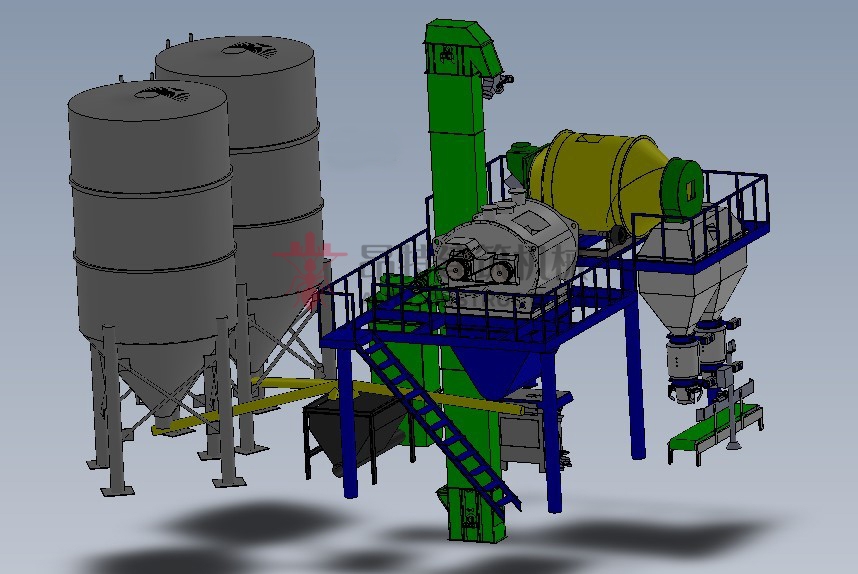Perlite mortar mix plant basic configuration and technology
Author:ANT CONSTRUCTIONS Comefrom: Createdate:2020/11/19 14:22:43 Hits:104
Perlite mortar mix plant basic configuration and technology
The wall insulation that is mandatory for building energy saving is mainly used for external wall insulation in practical applications, and the application of insulation materials are widely used in our life. One of the methods for external insulation of external walls is to use inorganic perlite insulation mortar, which is divided into three layers. The first layer is to apply a layer of bonding mortar on the leveled wall, the main function is to connect the wall and the insulation layer. The second layer is an insulation layer, using polystyrene particles to form a sheet or extruded board, or a mixed morta with polystyrene particles, perlite, vitrified beads and other lightweight materials; the third layer is anti-cracking layer, that is, apply crack-resistant mortar outside the insulation layer. According to the request, metal or glass fiber mesh materials are sometimes set in the crack-resistant mortar during construction. The inorganic thermal insulation prelite mortar is bonding mortar, inorganic thermal insulation mortar and anti-cracking mortar mixed with lightweight materials.
Inorganic thermal insulation mortar mix plant should at least meet the production of the above three mortars. The materials that make up the above mortar include cement, fine sand, fly ash, heavy calcium carbonate, etc., in addition to light materials, and auxiliary materials such as redispersible polymer powder, short fibers, calcium formate, etc. According to the characteristics of the product and the original materials, the output capacity, raw materials incoming stadus, we can make suitable solution and suitable configuration for thermal insulation mortar dry mix plant, now take automatic thermal insulation mortar mix plant produced by Henan Ant Construction as an example to explain the main configuration, for more details please visit our webtsite: antdrymix.com
Inorganic thermal insulation mortar mix plant configuration and process layout
If the workshop's height is enough, The design criterion of thermal insulation mortar mix plant is the main raw materials of cement, fly ash and sand are automatically measured, and other small qty materials are manually meastured. The main equipment configuration and corresponding functions are as follows:
3-4 powder silos, respectively storing bulk cement, fly ash and sand, equipped with a screw conveyor for discharge and weighing scale;
Sand bucket elevator for lifting sand to sand silo;
1 set of accumulative batching weighing scale, used for weighing cement, fly ash and sand;
one manual feeding hopper,
1 bucket elevator for lifting meatured materials of cement, fly ash and sand to mixer;
1 non-gravity double shafts paddle dry mortar mixer;
1 electric hoist used to lift all materials except cement, fly ash, sand,
1 premix hopper;
2 automatic dry mortar packaging machines;
1 control system ;
1 bag-type pulse dust collector
1 air compressor.
The layout of this kind thermal insulation mortar mix plant as below:

The cement silo and fly ash silo are arranged on the side of the mixer. The materials are transported into the silo by the bulk truck through pneumatic conveying, and the screw conveyor arranged under the silo will transport the materials to the top of the weighing hopper at the designed speed, and it is soft connection between the screw conveyor discharging port and the feed port of the weighing hopper; the sand is lifted into the silo by the bucket elevator, and the sand is the similar transporting method and weighing method to cement and fly ash.
The sand bucket elevator locate on the side close to the sand silo, and the feed opening is goes into a lower hopper, the opening is flush sand to silo. The outlet of the bucket elevator is above the bin, and the inlet of the bin and the weighing hopper is softly connected, and the conveying speed of the sand to the weighing scale is controlled by a pneumatic valve.
The metering scale is composed of weighing hopper, sensors, connector and pneumatic butterfly valve, etc., it is set on the side or above the mixer. The butterfly valve at the bottom of the weighing hopper which is softly connected to the material opening of the bucket elevator for mixer. The metering scale is designed according to the program to complete the weighing of cement, fly ash and sand, and then lifted by the bucket elevator for mixer to the pre-mixing hopper which above the mixer , and the pneumatic valve discharge the meatured materials from premix hopper to mixer.
The manual feeding hopper is set above the mixer and on the same working platform with the pre-mixing hopper.
The electric hoist is set on the side of the platform supporting the mixer, and the hoist's hopper lifts the materials to the platform where the manual feeding hopper is located.
The non-gravity mixer is placed on a platform on the first floor. The capacity of the mixer is 2 cubic meters. It adopts double door opening, discharge is fast and even. Depending on the product, a flying knife installation in the mixer is optional.
The waste hopper is set under the mixer and is closely connected with the unloading port of the mixer. If light-weight insulation materials are requested to be put into the mixer and mixed together, in order to avoid segregation due to the difference in particle size and bulk density during the falling of the materials, an anti-separation sliding plate is installed in the waste hopper to significantly reduce the occurrence of such phenomena. The waste hopper is designed with two discharge ports, which can feed two packaging machines at the same time.
2 unit dry powder mortar packaging machines. When the valve port packaging machine is selected, the feed port of the packaging machine is directly connected with the discharge port of the waste hopper, that is, it is placed under the waste hopper; the valve port packaging machine has two methods, the screw type and the airflow type.
The control system is divided into instrument control and computer control, centralized operation, all motors are designed with interlocking system.
One bag-type pulse dust collector mainly used for centralized dust removal at the feeding port and packaging machine. All other locations are designed with a full lock-off system to reduce dust points.
Analysis of main equipment and technological process of inorganic thermal insulation mortar mix plant:
Raw material storage and supply, According to the current situation, cement and fly ash supply is in bulk and the transportation equipment is improved, the demand of these two materials is large in the production of dry mortar mortar. Considering the capacity of the bulk cement truck and the production capacity of this set dry mortar production line. The storage capacity of the silo is 50 ton/silo, and the bulk truck directly pump the materials into the silos.
Sand drying equipment is expensive. At present, inorganic thermal insulation mortar manufacturers mainly purchase yellow sand or quartz sand that has been dried and screened. Most sand is packed in bags and stacked in the workshop. The system is designed an open hopper, which allows unpacked sand directly on the hopper, and the bulk sand can also be poured directly into the hopper with a trolley.
Auxiliary materials, such as polymer powder, fiber, etc., currently in bags, and light-weight materials are also mainly in bags, which are stacked in the workshop.
Cement and fly ash are fed into the weighing scale with a screw conveyor, and sand is fed into the weighing scale with a bucket elevator to extend the service life of the machine. These three materials are cumulative measurement in one weighing hopper. For example, the material used for one batch is 320 kg cement, 555 kg sand and 100 kg of fly ash. This formula is input to the instrument or computer. After the system is started, the system automatically starts the cement conveying screw. When the weight of cement goes into the weighing hopper reaches 320 kg, it will stop, and the sand discharge valve will be automatically activated. When the total weight of the two materials in the weighing hopper reaches 875 kg, the elevator will stop, and the fly ash conveying screw will be started at the same time. When the total weight of the three materials in the hopper reaches 975 kg, it stops, and the automatic measurement of the three materials is completed.
In addition to the auxiliary data other than the above three main materials, it is more reasonable to measure the light-weight insulation materials by volume method, and its consumption is small. This system is designed for manual measurement, and the electric hoist is used for lifting and transporting to the upper platform. The hopper is directly put into the mixer.
The non-gravity dry mortar mixer with a capacity of 2 cubic meters, the material filling volume is usually 1.2 cubic meters, for the bonding mortar or anti-cracking mortar without light materials, and the mixing weight is about 1.5 tons one batch. After the materials are put into the mixer, the mixing time is generally set between 200-400 seconds according to the performance of the original materials. The unloading door of the mixer for the production of dry-mixed mortar should adopt a wide-opening method, and the unloading speed is fast, and more importantly, the discharge is even and residue in the mixer should be as less as possbile. Continuously guarantee the quality of the mixed mortar.
Dry powder mortar packaging machine is divided into valve port packaging machine and open packaging machine.
The valve port packaging machine is designed with a tubular structure for the material discharge port. The inlet port of the valve bag is sleeved on the discharge tube of the packaging machine. When the mortar enters the packaging bag and reaches the set weight, the filling is stopped and the bag is closed automaticaly. When the material in the bag reversely moves to block the tongue-shaped opening at the mouth of the bag to prevent material leakage. With valve port packaging, the packaging process is simple and the product has a beautiful appearance. However, when lightweight materials such as polyphenylene particles and vitrified microbeads perlite are mixed together in the mixer, the air-flow packaging machine is recommended for packaging.
The discharge port of the open-mouth packaging machine is relatively large. It adopts a packaging bag with one side full open, which is directly sleeved on the discharge port, and is fixed by a bag clamping mechanism. The material is easier to be filled, and it is suitable for packaging of various mixed mortars. After the mortar enters the packaging bag and reaches the set weight, the entrainment mechanism is released, and the sealing operation is stopped by the sewing equipment, but it takes more labor.
Main characteristics of inorganic thermal insulation mortar mix plant
The main characteristics of this design is simple structure, compact layout,
fewer intermediate links,
smooth material movement,
small footprint, and low overall cost.
The selected equipment is relatively complete, with complete basic functions. In addition to the production of inorganic thermal insulation mortar, it can also be used for the production of ready-mixed dry mortar and other special mortars.







